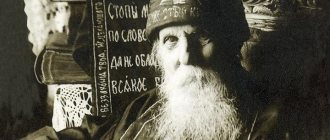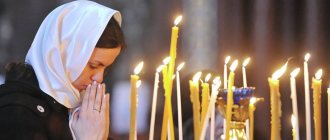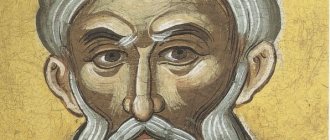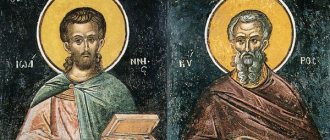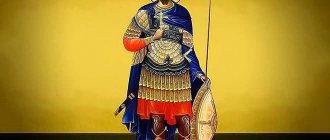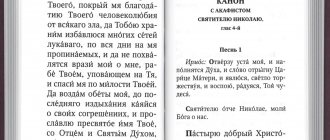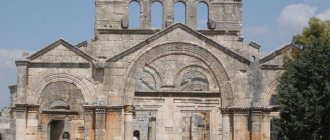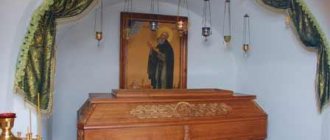Life of Arseny Konevsky
The future monk was born in Novgorod. First, he mastered the profession of a craftsman, then began to forge copper products. Then he became a novice at the Lisitsky Monastery - he became a monk there and acquired the name Arseny. The young monk lived on the territory of the monastery for 11 years and came to obedience. He felt he wasn't doing enough. That is why the monk went to Mount Athos to perform various spiritual deeds.
During his spiritual journey he lived in different monasteries. This went on for 3 years in a row. He made dishes from copper, communicated with Athonite monks, and then devoted all his time to prayer.
After years, it was time to return home. The monk came for a blessing to Abbot John, so that he would direct him on the right path. John blessed him with an icon of the Most Holy Theotokos, and then gave the canvas to the monk so that he could take it with him.
In addition to the icon, Arseny received a community charter. Arseny returned home. His further life is connected with Valaam. While still on the way home, the monk prayed to the Lord and asked him to indicate the place where he could build a monastery. The answer was received in an unusual way. When Arseny went out to sea, a storm occurred. The ship washed ashore on Konevets Island, which is located on Lake Ladoga.
It was then that Arseny understood God’s providence. He erected a cross here and later built a chapel. Construction dates back to 1398. Archbishop John of Novgorod blessed him for his action and advised him to give the monastery the name of the Blessed Virgin.
After construction, Arseny again went to Athos to receive a blessing and read prayers for his monastery. As soon as the monk left, the brothers began to feel the need for food. But John, who looked after the monastery, assured the monks that the future saint would return soon and bring provisions. And so it happened.
The name of Saint Arseny is associated with the name of Saint Euthymius, who visited the monastery and gave generous donations to the brethren. And he gave his hood to the venerable abbot. After his death, the saint was buried inside the walls of the monastery - the brothers took care of this.
Due to the events associated with the sea voyage, when the Lord showed the saint a place to build, Arseny is considered the patron saint of sailors and sea voyages. They say that once the saint saved an old man named Moses and the fishermen who were with him from death. According to legend, he appeared to them and overshadowed the boat with his mantle. Then the ship, despite the bad weather, safely landed on the shore.
The Life was compiled in the second half of the 16th century by the abbot of the Konevsky Monastery, who came to Valaam in 1850. At the same time, a word of praise was issued, and a service was written.
Hegumen-craftsman: the exploits and works of St. Arseny Konevsky
There was blood in the tracks of the horse's hoofs, smoke was wafting from the ashes of the forests, and above the ground stood the already silent cry of the dishonored, wounded, and beaten[1].
Second half of the 14th century. The Byzantine Empire is rapidly losing its power, the Romans are forced to cede more and more territories to the Gentiles, the terrible day of the fall of their Empire is approaching with inexorable speed...
Rev. Arseny Konevsky
Once upon a time, the Solun brothers translated liturgical literature in the Pannonian and Moravian principalities into Slavic. Later, the papal clergy, breathing envy of the Constantinople saints, expelled the disciples Cyril and Constantine, and they were forced to seek refuge in Bulgaria, with Tsar Boris. During that century, which separated the defeat of the Cyril and Methodius heritage in Pannonia and Moravia from the adoption of Christianity by Kievan Rus, it was the Bulgarians, the southern Slavs, who were the cultural and spiritual cradle from which Old Russian writing, the treasury of Russian Orthodoxy in the first centuries of its history, was destined to grow .
According to the Tale of Bygone Years, Prince Yaroslav the Wise was already creating scriptoriums in Kyiv, in which books that were vital for the spread of Christianity throughout the territory of what was then Rus' were copied and, perhaps, translated from Greek. However, liturgical, patristic and hagiographic literature begins to arrive in Kyiv, Novgorod, Chernigov and other Russian cities from the Bulgarian lands. The Patriarch of Constantinople becomes the immediate head of the Russian Church, and the Russian Metropolis occupies one of the last places in the list of those subordinate to Constantinople.
The Monk Anthony of Pechersk, the founder of Russian monasticism, who dug caves with his own hands on the outskirts of Kyiv, comes to Rus' from the Holy Mountain and brings with him the blessing of the Athonite elders, who taught the young ascetic the great science of monasticism. From the Kiev-Pechersk Monastery, like birds leaving their native nest, monks scatter across Rus', some of them become bishops, others found new monastic communities.
All this later began to be called the first South Slavic influence . It was this that gave the most powerful impetus to the formation of Russian cultural identity, which became the basis for the historical durability of the young Russian statehood and subsequently did not allow individual principalities, immersed in internecine strife, to forget forever about their common roots.
At this time, holiness was achieved along the paths of the martyrdom of the confession of faith by the princes
However, in the 14th century, Russian statehood was experiencing a deep crisis - Rus' lay in ruins, which had not yet stopped smoking after the terrible campaigns of Batu. Monastic life froze, and for a long time the Russian Church did not canonize the saints: at that time, holiness was more easily achieved along the paths of the martyrdom of the faith of the faithful princes...
Then, when the tremulous flame of faith was lit on Makovets by the young men Bartholomew, many of his contemporaries, who did not yet know about the imminent appearance of this spiritual nugget, to which the Patriarch of Constantinople himself would write several decades later, went south, to the South Slavic lands, and, of course, to Athos . And, in turn, talented scribes and bibliophiles came to Rus' from Serbia and Bulgaria, whose works became examples of church eloquence and standards of hagiographic literature. In the years of difficult trials that befell the Russian people, in the decades of humiliation and general despondency, there is a return to the cultural tradition of the southern Slavs, a search for meaning in the imprinted examples of Byzantine spirituality. All this later came to be called the second South Slavic influence .
Strong ties with Mount Athos were established in the second half of the 14th century in the Novgorod Lisyegorsk Monastery, located on the left bank of the Maly Volkhovets, not far from the Moscow road. In the 1390s, the abbot of this monastery, Hilarion, brought Nikon the Montenegrin’s “Taktion” from the Holy Mountain, and in the scriptorium of Lisya Gora, copies of this and many other manuscripts were created - the monks copied both liturgical books and theological works of their contemporaries. A little later, the monastery will become one of the centers of the Novgorod royal chronicle. Around 1382, a young Novgorodian came here, who would soon be tonsured with the name Arseny.
The life of Arseny was created shortly after his death by one of the abbots of the monastery he founded, Varlaam. Varlaam’s style later began to be compared with the style of a laconic northern icon, surrounded along the perimeter by stamps, which sparingly capture the main facts of the righteous man’s biography. The beginning of the Life is unusual - we have an annotation in which, as in the central part of the iconographic image, the content of the entire story is briefly described: Arseny visited the Holy Mountain, there he received the blessing of the elders and the icon of the Mother of God, after which he returned to Rus', where he created the Konevetsky Monastery. So, before us is a typical biography of a Russian monk of the late 14th – early 15th centuries, the era of the second South Slavic influence, when the source of monastic inspiration in the conditions of general cultural decline became the beautiful, distant Mount Athos, preserving the shrines of universal Orthodoxy in unshakable purity and unattainable grandeur.
Apollinary Vasnetsov. Ancient Veliky Novgorod
Arseny was born in flourishing Novgorod during the era of its historical and political heyday: the hordes of the Mongols never reached its walls and did not desecrate the altar of Hagia Sophia, the old capital and mother of Russian cities was already in ruins, and the new, insignificant town that had once been inherited by the youngest son Alexandra Nevsky to Daniil barely had time to declare her political ambitions. However, the historical perspective suggested that it was Moscow, and not Novgorod, that would become the centralizing force that would be destined to unite the Russian lands and overcome the cultural and ideological crisis, so acutely aware of Arseny himself.
Arseny’s refusal to be intoxicated by Novgorod’s originality and the isolation of the republic from other parts of the Russian world was also due to the fact that Arseny did not have the opportunity to enjoy the privileges that the Novgorod freemen promised to the representatives of their oligarchy: he was neither a posadnik nor a boyar - he was a simple artisan, a representative of the politically disenfranchised urban lower classes, the “black” or “lesser people” - the “copper forger.” Later, when the confrontation between Novgorod and Moscow reaches its climax, the “black” people will unanimously side with the strong central government in the person of the Moscow Grand Duke. “Smerd” is the hard worker Arseny, one of whose main character traits is his poeticized hard work, rejecting Novgorod elitism and not being able to see a unifying and confidence-inspiring democracy in the rising Moscow, his soul rushes to Athos.
So, Arseny is born into a family of poor Novgorod people, and the most valuable thing that his father passes on to him is a craft with which he can support himself throughout his life: the young man becomes a blacksmith. Arseny developed the habit of hard physical labor while still in the world; Working a lot - much more than his immediate expenses required - Arseny distributes the excess to the poor and beggars in the form of alms. Soon the young man comes to the Lisyegorsky monastery.
The cardinal monastic reform initiated during these years by the Patriarch of Constantinople and Sergius of Radonezh - the transition of monasteries from a separate to a cenobitic charter - did not always proceed quickly and consistently. Describing the life of Arseny on Fox Mountain, the hagiographer, on the one hand, writes about the difficult monastic obediences that the monk selflessly carried out in the tonsured monastery, on the other hand, he speaks about the shortcomings in the spiritual care of the brethren: the abbot of the monastery, although he highly valued Arseny’s obedience and humility, however, he never became his spiritual father. “We are tormented by spiritual thirst,” Arseny is looking for a leader, a shepherd who could teach him the wisdom of monastic life, and a possible way out of the impasse is relocation to Athos: it is here that one can gain monastic wisdom, enrich himself with the treasury of patristic tradition, here in the book depositories of ancient monasteries hidden are the works of theologians of our time and past times.
The idea of establishing a monastery according to the regulations of the Athonite monasteries becomes his dream
Fox Mountain maintains close ties with the Athonite monasteries, and at an opportune moment Arseny asks the abbot to send him to the Holy Mountain as part of a delegation of Athonite elders who arrived in Novgorod and are preparing to return. The abbot reluctantly says goodbye to one of his best students, however, realizing that it would be better for Arseny himself to become familiar with the life and traditions of the Athos monasteries, he releases the monk to the Holy Mountain. And indeed, Arseny undergoes the true school of monasticism on Mount Athos. The monk becomes a resident of the Russian Panteleimon monastery and the spiritual child of Abbot John, here he learns unquestioning obedience (“He rejected all his will and obeyed everything without judgment”), unfeigned humility (“Because someone is weak, someone can correct a good life without humility, if not before he humbles himself") and undergoes all types of the most grueling monastic labors, of which the most difficult were traditionally considered to be labors in the kitchen and bakery. With these exploits, Arseny managed to acquire the gift of tenderness and blessed tears. But only years after his arrival on Athos, the brethren learn about his blacksmith craft: thus, from a hardworking but unskilled laborer, Arseny turns into a skilled craftsman, whose works are in demand by both the abbot and the lesser brethren. Arseny forges church vessels, agricultural implements, parts of various mechanisms, and, as an inspired connoisseur of his craft, does it so well that soon rumors about his talent spread far beyond the boundaries of the Panteleimon Monastery, and monks from other monasteries come to the monastery and ask Arseny to help them with his art. The crowd of petitioners at the threshold of the saint’s working cell grows day by day, and one day Arseny decides to leave Panteleimon’s monastery and become a wandering Svyatogorsk monk-blacksmith. However, according to the spiritual laws of Athos, the payment for the services of a worker is not money, not food, not material values, but the prayers and blessings of those monks who happened to help the Novgorod forger named Arseny. Thus, with honest and inspired work, during the three years that Arseny worked as a blacksmith in various Athonite monasteries, he managed to obtain the blessing of many dozens of Athonite elders, leave in their monasteries a good memory of the Russian monk, and thereby lay the foundation for the future well-being of the Konevetsky monastery, because the thought of returning to his homeland and establishing a monastery in one of the deserted corners of the Russian North according to the rules of the Athos monasteries becomes his sincere dream.
Russian Athos St. Panteleimon Monastery
Arseny first talks about his plan to the abbot of the Panteleimon Monastery, John, and when he joyfully blesses him for this difficult and responsible feat, he goes around the other Athos monasteries and asks for the blessing of the elders and their holy prayers. According to Arseny, the new monastery should embody the best covenants of Athonite monasticism and become a bright light of monastic activity in the northern horizon of long-suffering Rus'. The Svyatogorsk elders listen with favor to Arseny’s speeches and promise him their prayerful assistance. Hegumen John, accompanying Arseny to his homeland, blesses him with the icon of the Mother of God, which becomes the main shrine of the new monastery and later receives the name of the Konevsky image. The main distinguishing feature of the image is the dove held in the hands of the Eternal Child; The icon was painted in the traditions of Byzantine painting of that time.
Returning to Novgorod, Arseny directly turns to the archbishop with a request to bless the construction of a new monastery, which he wishes to dedicate to the feast of the Nativity of the Virgin Mary. Arseny’s request might have seemed strange to the bishop, because the monk had no experience of hermit life, as required by the spiritual tradition of that era, he did not have those disciples who would have been attracted to him by the fame of his prayerful exploits at the site of the future monastery, moreover - the very place where the monastery was built was still unknown even to Arseny himself. However, not having all this, Arseny had the blessing of the Holy Mountain and the prayers of the Athonite elders, which, of course, he did not fail to inform Archbishop John about. The Bishop, having learned about Arseny’s three-year feat on Athos, remembering the bright memory that the monk left behind on Fox Mountain, blesses him to build a new monastery, equips him for the waterway (Arseny, according to the favorite tradition of Russian monasticism, wants to build his monastery on a secluded island in the middle of the lake) and finds companions for him, who are destined to share with the monk the first, most difficult labors of building a monastery.
The lake in whose waters Arseny decided to look for the blessed corner became Nevo (that’s what Lake Ladoga was called at the beginning of the 15th century). Having loaded “all sorts of necessities” into a flat-bottomed boat, Arseny “and his comrades” set sail. Quite soon the monk reaches Konevsky Island, but Arseny is attracted by other countries, more distant from large villages, more secluded, and he commands the shipmen to rule to the north: there, beyond the horizon, in the land of undeterred birds, he can find a quiet refuge for work and prayer.
The monk perceives the return to the island as a manifestation of Providence
However, bad weather forces the monks to land on the shore at the mouth of the Gorodets River. Clouds cover the sky, and Arseny gives his word to found a monastery where he will land immediately after the storm subsides and the boat can continue its journey. When the sky clears, Arseny, together with his companions, sets sail from the shore: it seems to him that the northern islands are waiting for him, where, perhaps, no man has set foot, and Konevsky Island, left far behind, the island that became the center of a pagan cult, is not even comes to his mind. But God was destined to return to Konevets: as soon as the bait reaches wide water, gusts of strong wind carry it not to the north, as Arseny wanted, but to the south. The monk perceives his involuntary return to Konevsky Island as a manifestation of Divine Providence. As they approach the island, travelers clearly hear the sounds of bells ringing, and Arseny turns to his comrades with the words: “Behold, for one hour the Most Pure One has placed us here.”
Arseny arrives on Konevsky Island, accompanied by reliable people who accompany him at the behest of Bishop John, but spends the first time in the desert alone: he builds a hut, puts up a worship cross on an elevated place and lives in solitary prayer for a year. It must be assumed that Arseny’s connection with the mainland was never interrupted, and the monk could receive from the Novgorod archbishop everything necessary to ensure the normal functioning of the nascent community. The monastery around Arseny’s hut did not take shape immediately, gradually, in its own time. However, in the first years on Konevsky Island, Arseny becomes close to the local residents; a fisherman named Philip becomes his friend, who leads the monk to the stone sacrificed to idols.
Konevsky Nativity of the Mother of God Monastery
Arseny first learned about the existence of this stone, perhaps, during his first visit to Konevsky Island, when he walked around its territory, “like a fir tree with greyhounds.” The place seemed unclean to the monk, and that is why he decided to look for another refuge for his future monastery, but the Mother of God judged otherwise. That is why now, when Philip turns to him with a request to clear the island of the idolatry, Arseny perceives his request as a responsible challenge that must be accepted, armed with courage, prayer, and most importantly, taking in his hands the holy image of the Mother of God, which he brought from the Holy Mountain.
The stone, whose magical power needed to be neutralized by the monk, served as a place for sacrifices of livestock and, first of all, horses. That is why the island began to be called Konevsky. Later, the Russian writer Fyodor Abramov began to talk about the role that horses once played in the life of the Russian peasantry: “The first toy of a peasant son is a wooden horse. The horse looked at the child from the roof of his father's house, the mother sang and told about the hero horse, about the burka, the horse, as he grew up, decorated the spinning wheel for his betrothed... Everything is a horse, everything is from a horse: the whole life of a peasant, from birth to death…". The reverent attitude of the peasant to the horse is not at all surprising and was reflected in many works of Russian literature of the 19th century: a peasant family, deprived of a horse, was doomed to need, and sometimes poverty, and saw in the most pitiful nag a nurse and savior from starvation.
A flock of crows suddenly appears and flies away with a loud roar. The island is cleared of demonic forces
The local peasantry elevated this horse worship to a cult, directly deifying the horse and sacrificing live horses to it. The pagan custom was deeply rooted in the minds of the local residents, and remarkable courage was required in order to stop its manifestations at the site of the cult stone. Arseny prays for a long time, arms himself with the Svyatogorsk icon and performs a prayer service at the site of the ancient temple. The fishermen, waiting with bewildered horror to see what kind of punishment will befall the old man who blasphemed a pagan shrine, are surprised to notice that Arseny remains unharmed, while a flock of crows that suddenly appears with a loud roar flies away to the north, sobbing “like roaring oxen.” . The island is forever cleared of demonic forces.
From this time on, the monastery began to grow and develop. Many pilgrims and pilgrims come from Novgorod to Arseny for spiritual conversation and advice; the monk receives and reposes each traveler, trying to console him with a good meal. But one day one of the perspicacious elders of the monastery hears a conversation between two demons, one of whom joyfully notes that the structure of the monastery allows the abbot to have hazing in his cell. This deviation from the strict precepts of the communal rules becomes the gap with the help of which the demon hopes to undermine the strict monastic discipline. Having learned about this demonic conversation from the perspicacious elder, Arseny orders that any eating in the monastery be limited to the walls of the common refectory.
Arseny Konevsky against the backdrop of the monastery he founded (icon, first quarter of the 19th century)
The monk does not lose his living connection with the Holy Mountain. Arseny visits Athos more than once after monastic life began on Konevsky Island. However, the long absence of the abbot always becomes a serious test for the inhabitants of his monastery: the monks feel abandoned by their mentor, and one day the orphaned flock gathered by Arseny is already preparing to leave the monastery, because the supplies of provisions have dried up, and the elder is still “in a distant country.” At this tragic moment, one of Arseny’s students named Joachim, realizing the full danger of the current situation, ascends one of the mountains of Konevsky Island and in heartfelt contrition prays to the Mother of God that the monastery of the monk will not be abandoned. That same night, Joachim has a prophetic dream, from which he learns that Arseny is only a few days' journey from the monastery and is bringing with him ships full of provisions and everything needed to establish the monastery's economy. Joachim hurries to encourage the brethren, and the monk himself, arriving at the monastery the very next day, reminds the monks that the Kingdom of Heaven must be gained through many sorrows.
One of these sorrows was the severe flood of 1421, mentioned in the Novgorod chronicles, when water approached the monastery buildings, flooded the church threshold, and stood knee-deep inside the cells and refectory. Arseny realizes the need to move the monastery to another, more elevated place, but the question of the location of the church and other monastic buildings should be decided not on the basis of pragmatic promises, but where it was destined from above. The monk earnestly prays to the Mother of God that She would reveal Her will to him, and soon sees in a dream himself and his longtime friend, the fisherman Philip, fencing one of the elevated meadows of the Konevsky Monastery. Arseny notices that Philip, having noticed him, hastens to leave, as if fearing to be caught in his involvement in the undertaking. The monk, however, overtakes Philip in reality and takes him by surprise with an unexpected question about where he was the previous night. “I’ll go to the camp with my comrades, honest father,” answered Philip, who was embarrassed, but when Arseny insinuatingly asks him in a quiet voice what he saw in his dream that night, he confesses that he was busy fencing the territory of the new monastery and disappeared from the eyes of the monk, as soon as he noticed him.
A simple fisherman, the same poor man as Arseny himself, becomes his associate
An amazing episode that has no parallels in the plots of other lives! Arseny’s comrade and companion is not an angel, not a reverend predecessor, not one of the saints, and not even his disciple dressed in a monastic robe - his companion becomes a simple fisherman, a man of manual labor, the same poor man as Arseny himself once was. It was this worker of the sea (Lake Ladoga was often called the sea by local residents) who was destined to open a holy place where the monastery would finally be built... The name of Arseny’s friend is also noteworthy - Philip, that is, “who loves horses.” The temptation is too great to see in the image of this Philip only a symbol of the entire local peasantry, and indeed the Russian peasantry in general with its characteristic love of horses. After all, it is in the collaboration of the hardworking clergy in the person of abbot-master Arseny and his students, on the one hand, and pious local residents in the person of Philip and his comrades, on the other, that the Konevskaya monastery is born, the inhabitants of which are destined to overcome pagan prejudices and sanctify the Russian land with light Orthodox faith, lit on the Holy Mountain.
The Konevsky monastery truly spreads already on the second, more elevated place, where the monk applies labor to labor, cuts down forests, builds new cells and, together with other monks, re-erects the Cathedral of the Nativity of the Virgin. The monk dies in June 1447 at a ripe old age, on the day of remembrance of Onuphrius the Great and Peter of Athos, surrounded by his faithful disciples, and one of his main covenants to the assembled brotherhood at his death becomes the covenant to preserve in the monastery the charter of the Holy Mountain, in the image and likeness of which it was organized monastic life of the Konevsky Monastery.
Veneration of St. Arseny in Orthodoxy
Believers respect the abbot of the Valaam Monastery. Evidence of the veneration of Arseny dates back to the 16th century. This was first mentioned in connection with the laying of a veil on which the image of the monk was embroidered. They compiled legends about the Valaam Monastery, which was written in 1550, they talk about the greatest leader Arseny.
The first miracle that occurred after the death of the monk was associated with 1573. Then a resident of Karelia, Afanasy, by the name of Belyai, was captured to work for one of the Swedish soldiers. Athanasius often prayed before the icon of the Savior. One day in a dream the Lord appeared to him and ordered him to go to Konevetsky Island with the icon. There Arseny appeared to Athanasius and pointed out the path along which he could escape.
Further miracles involve healing. Those who touched the relics of the monk began to see.
This happened to Elder Thomas, who was blind from birth. He asked Arseny to let him see the world for a few minutes before his death. The saint helped Thomas; he restored his ability to see for 2 days. Then Thomas died, but before his death he glorified the saint, prayed to him and forced his brother monks to do so.
The veneration of Saint Arseny is described by the monthist Simon Azaryin. Veneration falls on September 8th. And glorification is celebrated on June 12.
Empty
- Seal
Blessed Arseny came from Veliky Novgorod, but it is unknown who his parents were and at what time he was born. His heart, inflamed with the love of Christ, prompted him to leave the world to seek the silent life. First, he retired to the monastery of the Nativity of the Virgin Mary, neighboring Veliky Novgorod, on Fox Mountain.
The saint lived there for eleven years, having completed the monastic test, cut his hair and became a perfect monk. All the brethren looked at him as a model of monastic life given to them from above.
NOVOGORODETS ON ATHOS
The desire to visit the Holy Mount Athos had long lived in the soul of the Monk Arseny, and he took advantage of the coming to Novgorod of a certain Athonite monk. Falling with tears at the feet of the abbot, Arseny begged to be released to Mount Athos. For a long time the abbot did not agree to his request, feeling what a deprivation it would cause for the monastery, but finally he could not help but yield to the tearful prayer of the zealous monk.
Arseny joyfully went on his way with a fatherly blessing, and safely reached the Holy Mountain, where he was lovingly received by Abbot John. The abbot ordered the stranger to strive in common labors with the brethren. Therefore, Arseny went through all the monastic services in order, starting with woodworking and baking bread, and performed every service with extreme humility and obedience, considering himself to be the worst of the brethren.
The abbot, having learned the art of the Russian newcomer forging copper vessels, occupied him preferably with this handicraft, and in deep silence he forged vessels for the needs of the monastery, devoted the whole day to this, and spent the night in prayer, barely allowing himself little rest, for he was strong and courageous . He worked without compensation not only for his monastery, but also for other Svyatogorsk monasteries; for from everywhere they brought him copper for forging vessels, as soon as they heard about his art. It is not known in which actual monastery the Monk Arseny asceticised; however, it must probably be assumed that in Rossikon, for it was the common refuge of all Russian newcomers.
Fearing that the multitude of those who came to him would not burden the brethren of his monastery, he accepted the blessing from his abbot to go around all the monasteries of the Holy Mountain in order to work for the benefit of each of them, not for the sake of gold and silver, but for spiritual salvation, and remained in such a feat for three of the year. Then the desire came to him to return to his native land in order to establish a monastery there for the glory of the Mother of God, in Whom he had warm faith. Arseny began to ask the abbot for leave to his homeland, and he, filled with the spirit of clairvoyance, prophetically told him that the Lord would build through him a monastery in the northern country, which would be saved by his prayers from many demonic charms and superstitions.
The abbot fatherly blessed him with the double icon of the Lady with the Eternal Child on the one hand, and the Holy Image of Spasov on the other, giving him the Charter of the Holy Mountain. Letting him go, he prayed over him like this: “God our father, look from the throne of Thy glory on Thy servant Arseny, may the grace of Thy Holy Spirit always rest on him and Thy blessing be with him.”
NORTH HOUSE
In 1393, Blessed Arseny returned to Veliky Novgorod, carrying with him the miraculous icon of the Mother of God from the Holy Mountain, later called Konevskaya. Here he appeared before Archbishop John II, to whom he told everything that had happened to him on Athos, and asked for his blessing to create a monastery in the north in the name of the Nativity of the Virgin Mary. The bishop released him in peace, and Arseny with the icon of the Mother of God sailed into Lake Ladoga.
Having been in the Valaam monastery, he decided to go into silence to more secluded places and, by the Providence of God, reached the deserted island of Konevsky. From here the monk decided to go further, but the wind drove the boat in which he and his disciples were sailing back. Here, around 1393/94, a monastery arose, and in 1398 a temple was erected in the monastery in honor of the Nativity of the Virgin Mary. The monk expelled demons from the Horse-stone located on the island (hence the name Konevsky), to which the pagans made sacrifices. After Saint Arseny, together with the monastery priest, sprinkled the stone with holy water, the fishermen saw a flock of ravens flying north and roaring like oxen.
After the exorcism of demons, according to monastic tradition, the monk blessed the construction of a chapel on the top of the Horse-Stone. After the establishment of the monastery and the increase of the brethren, the Monk Arseny again went to Holy Mount Athos, this was under the Novgorod Archbishop Simeon (1416-1421). Then there was a great scarcity in his monastery, so that the brethren, overcome by hunger, wanted to disperse. But one of the elders, named Joachim, adorned with piety and gray hair, ascended the mountain closest to the monastery, where the monk first labored, and prayed to the Heavenly nourisher Mother of God to send them their daily bread.
Rev. Arseny Konevsky.
After a long prayer, the elder dozed off, and through a subtle sleep the Mother of God appeared to him in Heavenly glory. “Don’t grieve, elder,” She said in a quiet voice, “tell the brethren not to leave this place, for soon Arseny himself will come to you with an abundance of everything you need for the monastery.” The next day, Arseny actually sailed on two large ships and brought with him a lot of supplies.
In 1421, an extraordinary flood of Lake Ladoga, which washed away some of the buildings of the poor monastery, forced the Monk Arseny to move the monastery to a new place on the same island, where little by little he built a stone church with wooden cells and a fence. Archbishop Euthymius, who entered the department from the Lisichy Monastery, greatly assisted the monk in establishing a new monastery. Konevets then became famous for many in Novgorod. Pious Novgorodians began to visit the monastery secluded on the island and delivered their benefits to it.
In his cares and labors for the good of the monastery and in the exploits of monasticism, the Monk Arseny reached a very old age. Even during the life of the monk, John became hegumen of the Konevsk monastery. Before his repose, Saint Arseny bequeathed to the brethren of the monastery to keep the Rule of the Holy Mountain, “to keep the meal equal.” Entrusting his monastery to the Mother of God, he promised in spirit not to part with the brethren and at the very moment of his exodus, supported by his disciples, he partook of the Divine Mysteries and peacefully departed to the Lord on June 12 (25), 1447, on the day when the Holy Church celebrates the memory of Saints Onuphrius and Peter of Athos, following whose example he labored. The Charter of the Holy Mountain, introduced by the Monk Arseny in the Konevsky monastery, was adopted in 1865 by the Verkolsky Artemiev Monastery in the Pinezhsky district of the Arkhangelsk province.
MIRACLES AND REVERENCE OF THE REVEREND
The Monk Arseny is revered as the patron saint of sailors. So, once he saved the elder Moses and the fishermen from death. The fishermen caught in the storm prayed to the Lord; The saint who appeared overshadowed them with his mantle, and the boat safely landed on the shore. Evidence of the veneration of St. Arseny has been preserved since the 16th century. Since the 18th century, the troparion, kontakion and prayer to St. Arseny of Konevsky have been known, and in 1819, by decision of the Holy Synod, the name of St. Arseny was included in all monthly books.
Pimen, Archimandrite of Konevsky and Valaam († December 22, 1910), the author of the description of the monastery, reports that the relics of St. Arseny were found in the 16th century, but during the Livonian War (1558-1583) they were again buried near the western wall of the Church of the Nativity. In 1577, after the capture of the Konevsky monastery by the Swedes, the brethren, together with abbot Leonty, moved to the Derevyanitsky monastery, taking with them the miraculous Konevsky image of the Blessed Virgin Mary. The Swedes destroyed the Nativity Cathedral of the Konevsky Monastery.
On June 12, 1809, a new stone Cathedral of the Nativity of the Virgin Mary was consecrated, built on the site of one destroyed by the Swedes, and on August 21, 1849, St. Ignatius Brianchaninov consecrated a new church in the monastery in the name of St. Arseny Konevsky. In May 1991, the Konevsky Monastery was transferred to the Russian Orthodox Church, and in November of the same year, the relics of St. Arseny were found under the floor of the lower Sretensky Church of the Nativity Cathedral.
Published based on the book: “History of the Russian St. Panteleimon Monastery on Athos from ancient times to 1735.” Series “Russian Athos of the 19th-20th centuries”, volume 5. – Athos: St. Panteleimon Monastery, 2015 .
See also
To give your life for others: several facts from the life of Schemamonk Glikeriy (Nikitin). Day of Remembrance
Every person has at least one opportunity in life to prove the sincerity of their faith in God, to show their love for Him and people, but we often do this...
Hieroschdeacon Benedict. Memorial Day - December 24
Hieroschdeacon Benedict, a Greek by birth, lived on Holy Mount Athos for more than 70 years. He was a very educated and highly spiritual monk. The Patriarch of Constantinople sent three times...
Assistant to the tireless elder: Hieroschemamonk Vladimir (Kolesnikov). Memorial Day - December 23
Hieroschemamonk Vladimir (in the world Vasily Vasilyevich Kolesnikov) was born on July 27, 1851 in the village of Chudovo, Novgorod province. His father Vasily and mother Evdokia died...
Secretary of the Athonite Elder Macarius, Hieroschemamonk Mina (Budanov)
On December 3, 1888, Hieroschemamonk Mina (Budanov), the long-term secretary of the Athonite elder Macarius (Sushkin), abbot of the Russian on ...
The work of God must be done without delay: Hieroschemamonk Arseny (Minin). Memorial Day - 30
No one ever heard an idle word come from his lips. Father Arseny was often silent and thoughtful, those present with him felt that in his heart...
Confessor and cathedral elder: Hieroschemamonk Theodoret (Konstantinov). Memorial Day - November 19
Hieroschemamonk Theodorit (in the world Fedor Semenovich Konstantinov) was born in 1856 into a peasant family in the village of Pogozhem, Timsky district, Kursk province. His mother's name was...
The oldest copy of the miraculous Kazan Icon of the Mother of God from the Panteleimon Monastery on Mount Athos
On November 4, in the Athos St. Panteleimon Monastery, they prayerfully honored the memory of the Kazan miraculous icon of the Mother of God, reports a correspondent of the Russian Athos portal.
Strict ascetic and hospitable governor: Hieroschemamonk Gerasim (Popov). Memorial Day - October 26
Hieroschemamonk Gerasim (in the world Gleb Petrovich Popov) was born on June 24, 1859 into a peasant family in the village of Rozhkovech, Oryol province. Subsequently, his family moved...
Hieromartyr Hilarion (Gromov). Memorial Day - October 11
“Dear father! Our life is hard and bitter,” the future new martyr wrote to the abbot of the Panteleimon Monastery. “There are no words to express to you the sadness that has visited us.” We, …
How to learn humility: Schemamonk Onisifor (Ishchenko). Memorial Day - October 11
Schemamonk Onisifor (in the world Onisim Karpovich Ishchenko) was born in 1872 into a peasant family in the village of Rubanskoye, Bratslav district, Kamenets-Podolsk province. Since childhood he was silent...
- Tags:
- Athos
- Holy Mountain
- Panteleimon Monastery
- Konevsky Monastery
- Arseny Konevsky
Icon of Arseny Konevsky
The first images that have survived were made on the cover, which was brought to the altar where the relics were buried. Icons appeared much later. On the canvases the monk is depicted in full growth, standing upright, dressed in monastic robes. His head is uncovered, his face is hidden under a beard, and with his right hand he points towards the scroll that he holds with his left hand. The upper part of the canvas is decorated with a signature.
On the lid of the reliquary, which is made of silver, the saint is depicted with his eyes closed. He wears a schema and a special headdress on his head. The arms are folded crosswise on the chest. The bas-reliefs of the reliquary's faces are decorated with scenes from its existence.
Most often, Konevsky’s iconography is characterized by waist-length images. They became widespread in the 19th century. In addition, Arseny was often depicted with an icon of the Mother of God in his hands. It was assumed that this particular icon was brought by the monk from Athos.
Another icon painting type emerged in the second half of the 19th century. At the same time, a new edition of Genesis was published. They began to depict the monk against the background of a stone monastery, which he built at the behest of the Lord. With his right hand he points to the walls of the monastery, with his left hand he holds a scroll, which contains the communal rules for the monastery brethren. The type of buildings occupies a special place. The monastery is depicted from the harbor side or from the stone bell tower.
Researchers believe that the iconographic originals liken Arseny’s appearance to the appearance of Sergius of Radonezh or Joseph of Volotsky. These images became for Russian icon painters the basis of icon painting.
How does the icon of Arseny Konevsky help?
They pray to Saint Konevsky for protection during sea voyages. Several centuries ago, the life of sailors was associated with constant dangers and often ended in tears. That is why the saint was remembered much more often.
Today he is still the patron saint of sailors, but now he is also the patron saint of ordinary travelers. In addition, the monk instills confidence in one’s abilities if one turns to him during doubts and searches.
Quite often, mothers of children who have connected their lives with service in the navy turn to the monk. They pray that the patron will look after their sons and save them from danger and troubles.
The icon can be included in the home iconostasis as the second or third row. It is better to turn to the monk when your thoughts are cleared of everyday problems. It is better to choose early morning for calls. It is believed that the holy abbot of the Valaam Monastery got up very early, even before dawn.
